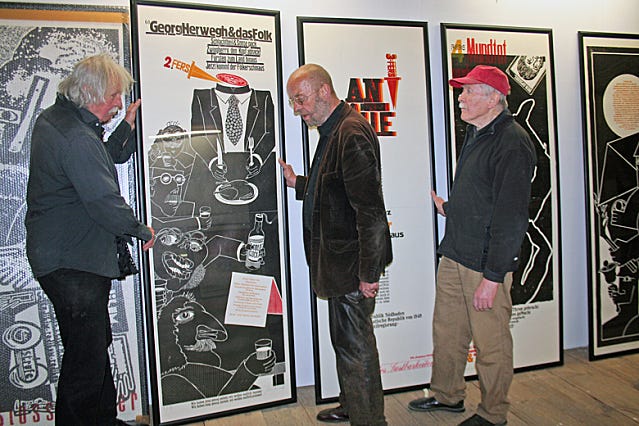Introducing the Rixdorfer Print Workshop
Impressions of Berlin in the ‘60s & ‘70s
In 1963, a group of friends in West Berlin — four intrepid journeymen of art and design — got their acts together and took possession of a big fourth-floor space on Oranienstrasse, creating the Rixdorfer Print Workshop (Werkstatt Rixdorfer Drucke).

Helping them was their patron, Günter Bruno Fuchs, principal operator of the gallery ‘zinke,’ housed in a rickety building down the street. Zinke’s edgy salons, readings and concerts had made it a legendary “scene” for emerging youth culture in postwar Berlin. [Decades before he was a Nobel Prize-winner, Gunter Grass was forced to speak from an upstairs window, reading his work to listeners on the street, a mass of humanity that threatened to buckle the scruffy building’s timbers.]
Fuch helped his young friends, the Rixdorfer crew, search for a new place and found the old factory building on his own street, at Oranienstrasse 20. Carrying a prankster-bohemian spirit of the times, the young almost-30-somethings of the Rixdorfer Workshop — Uwe Bremer, Albert 'Ali' Schindehütte, Johannes Vennekamp, and Arno Waldschmidt — moved in. It came with some old machines they’d bought for almost nothing: a Boston letter press and a shambly paper-cutter.
Some battered boxes of type-setting tools also went with the deal — also letter type-blocks of varying sizes and fonts, all made of wood and lead. With all this great “retro” technology, the men do what boys do: They began experimenting (=playing) with the colorful mix of mostly old-fashioned typefaces. The four approached their new work with carefree humor, casually — almost randomly — grabbing and setting type. The result became the Rixdorfer brand of “typographical madness” (Typographischer Irrsinn), producing work that conventional printers couldn’t even try to match.
They got good at it. The result is a very large and under-recognized body of work. The printed works of the Rixdorfer Workshop have been described, variously, as spontaneous, anarchic, poetic, ironic, improvisational, subversive, un-serious, joyful, subtle, provocative, and sometimes-political.
And, in the meantime, the Rixdorfers recruited young German writers to contribute scores of texts to the Rixdorfer treasure of lavishly designed printed matter. These have included: Peter Bichsel, Nicolas Born, Ernst Jandl, Sarah Kirsch, Michael Krüger, Reinhard Lettau and Peter Rühmkorf.
Keep reading with a 7-day free trial
Subscribe to Berlin Stories to keep reading this post and get 7 days of free access to the full post archives.


